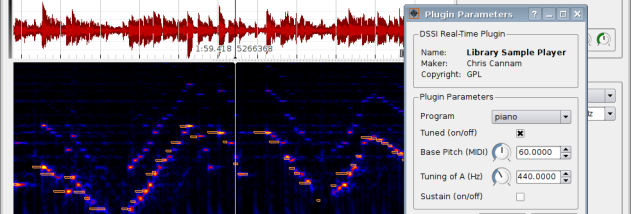

Furthermore, it comes with a set of integrated plugins that allow automatic calculations of annotations, taking into account tuning and sound pitch. One of the worth-mentioning features is the possibility to import and overlay annotation layers (CSV, LAB, MID, TXT) on top of waveform representations. For your convenience, This software can also slow down the playback to such an extent that it reaches 10% of the initial speed. The selection tools enable you to define waveform sections and compare them much easier. As such, you can freely adjust the zoom level both horizontally and vertically, so as to focus on any area of the waveform and analyze it in detail.

The application features options for modifying the way data is displayed. The work the program does is intrinsically processor-hungry and (often) memory-hungry, but the aim is to allow you to work with long audio files on machines with modest CPU and memory where reasonable. It is pervasively multithreaded, loves multiprocessor and multicore systems, and can make good use of fast processors with plenty of memory. Even if you have to wait for your results to be calculated, you should be able to do something else with the audio data while you wait.

To provide the best available core waveform and spectrogram audio visualizations for use with substantial files of music audio data.The design goals for Sonic Visualiser For Music Analyzing Export audio regions and annotation layers to external files.Time-stretch playback, slowing right down or speeding up to a tiny fraction or huge multiple of the original speed while retaining a synchronized display.Select areas of interest, optionally snapping to nearby feature locations, and audition individual and comparative selections in seamless loops.

Playback the audio plus synthesized annotations, taking care to synchronize playback with display.Import note data from MIDI files, view it alongside other frequency scales, and play it with the original audio.Import annotation layers from various text file formats.Run feature-extraction plugins to calculate annotations automatically, using algorithms such as beat trackers, pitch detectors, and so on.View the same data at multiple time resolutions simultaneously (for close-up and overview).Overlay annotations on top of one another with aligned scales, and overlay annotations on top of waveform or spectrogram views.Annotate audio data by adding labeled time points and defining segments, point values, and curves.Look at audio visualizations such as spectrogram views, with interactive adjustment of display parameters.Load audio files in WAV, Ogg and MP3 formats, and view their waveforms.Sonic Visualiser For Analyzing Music Features manipulating sonic-visualiser environment files. Moreover, it enables you to import from music note data from locally stored MIDI files and display it alongside the waveform. inaFaceAnalyzer is a Python toolbox for large-scale face-based analysis of image and video streams. It aims to provide a user-friendly tool for displaying spectrograms and audio waveforms, ensuring compatibility with some of the most common audio formats (such as WAV, MP3, AIFF, AVR, FLAC, OGG, RAW), as well as less popular file types (AU, CAF, HTK, IFF, MAR, MPC, PVR, RF64, SDS, W64, WVE, XI). It mainly uses for viewing and analyzing music files. It’s designed for musicologists, archivists, signal-processing researchers, and anyone else looking for a friendly way to look at what lies inside the audio file. Sonic Visualiser is a free, open-source application for Windows, Linux, and Mac, designed to be the first program you reach for when want to study a music recording closely. We also have other export formats that can be used to view data in the frequency domain, these include. There is software such as MATLAB that can convert TD to FD data, the following link may be of interestĪlternatively, Ben has an option here topic22135.html where he has exported PSdata from the Time Domain and imported/viewed in Sonic Visualizer The csv export of NVH data is from the Time Domain only and therefore no frequency data is present


 0 kommentar(er)
0 kommentar(er)
